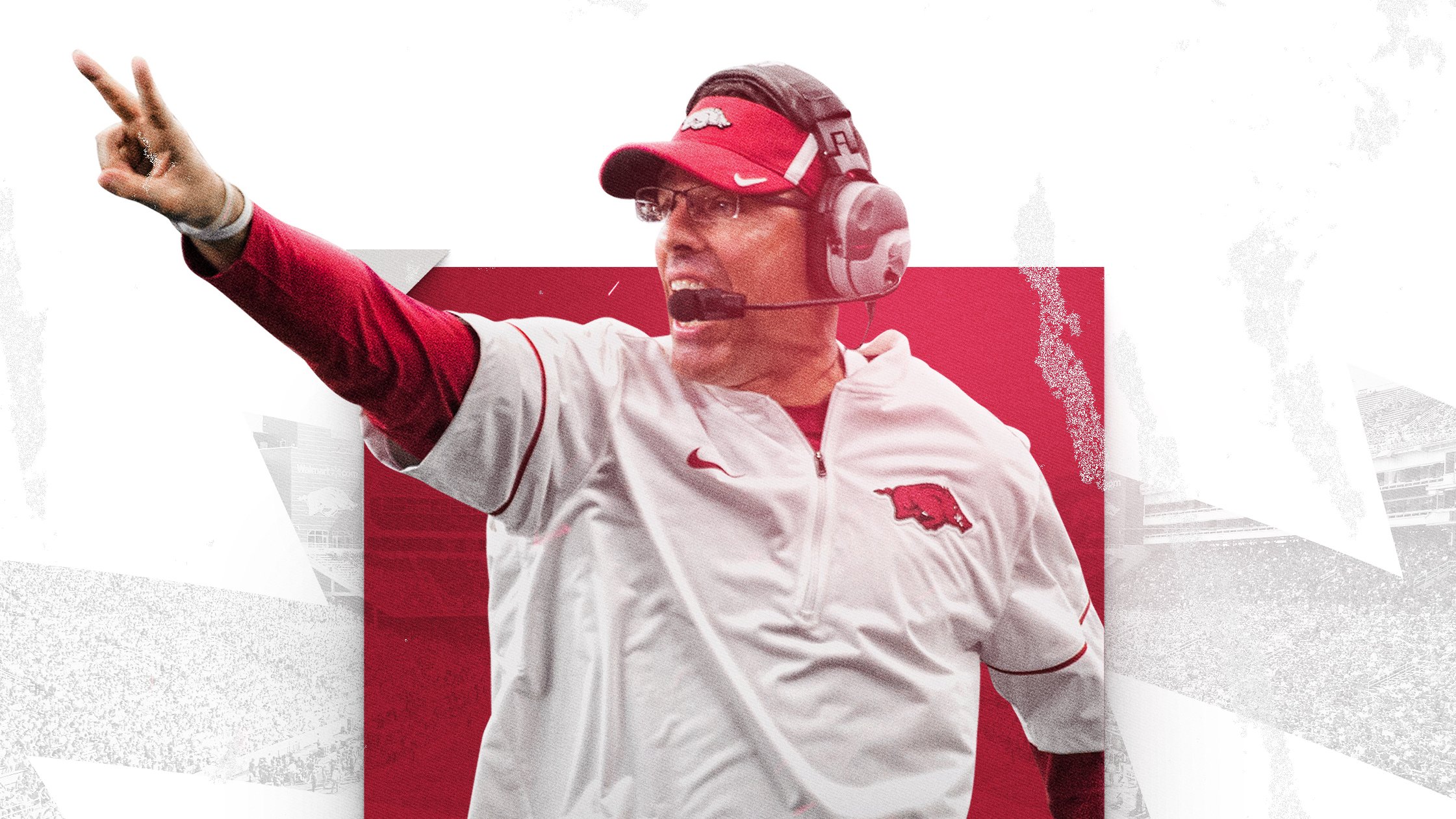The Razorbacks wasted no time moving on from Kendal Briles, announcing Dan Enos as the new offensive coordinator before Briles was even announced at TCU.
In this post, we will dive into the Dan Enos offense, including his first stint at Arkansas from 2015 to 2017, and what he’s changed in the years since he’s been gone.
Ugly end to the Briles era
Arkansas was clearly prepared for Briles to leave long before it became official. It’s not really clear what happened at the end of Briles’ three years in Fayetteville. He did a nice job, but situational playcalling was not a strong suit, and that drew the ire of fans.
Briles was apparently deep in talks with Mississippi State, but ended up turning the Bulldogs down to remain in Fayetteville, making his now-infamous “run it back” post on Twitter. But within a week or so, he was connected to the TCU job and is now gone. It seems likely that he was just using the Mississippi State job for a raise but had legitimate interest in returning to his home state of Texas. His hire has not been well-received by the TCU faithful, given their rivalry with Baylor and proximity to the Art Briles scandal.
The Dan Enos offense
We’ll run through Enos’s history, but he doesn’t have a single “system” and instead adapts his offense to fit his personnel. He is a very good playcaller and tends to make life very easy for his quarterback.
A few things are consistent with Enos at every stop:
- Lots of quick rhythm passes. Enos QBs tend to have very high completion percentages because Enos gives them a lot of simple reads on early downs to soften up the defense. These tend to be horizontal (in a West Coast style) to force the defense so stretch sideline-to-sideline, opening up the run and deep passing game.
- Pass sets up the run. If you’ve misremembered Enos’s first stint as OC and are worried that Arkansas is reverting to a smashmouth “three yards and a cloud of dust” scheme… then don’t. Enos offenses tend to be about 55-45 run-pass, compared to 63-37 run-pass for Arkansas in 2022. Enos will use his West Coast background to dial up those horizontal passes to spread the defense and create running lanes. The Hogs will not be trying to pound the ball straight into loaded boxes.
- Deep throws off play-action. A combination of horizontal passing and downhill running will eventually force opposing safeties to start peeking into the backfield or the flats. Enos loves old-school play-action throws down the field to create big plays.
- Heavy use of the tight end. Enos likes all-around tight ends who can block and also catch passes. At least one tight end will always be on the field, and the position will serve as a checkdown or a complement to the other parts of the offense.
- Receivers as blockers. Enos has used different run schemes in different places, but he does seem to love using receivers as blockers, especially when receivers line up near to the formation. Arkansas’ 2015 team in particular created a lot of long runs because receivers set up great downfield blocking. That comes up a lot in watching Maryland as well.
All of these were part of Enos’s first Arkansas stint and have been part of all of his offenses since. However, he has changed some things.
Arkansas, 2015-2017
Any Hog fan excited about the Enos hire is thinking of Arkansas’ 2015 offense, which was amazing. The Hogs averaged 465.5 yards per game and 35.9 points per game, which is about the same yardage and three more points per game than this year’s team. (For what it’s worth, three more points per game would turn Arkansas’ record from 7-6 to 10-2-1.) Brandon Allen threw for 3,440 yards (9.3 per attempt) and 30 touchdowns while Alex Collins rushed for 1,554 yards and 20 scores. That team lost 1,000-yard rusher Jonathan Williams before the season and then returning receiving leader Keon Hatcher in the second game, which makes their season that much more impressive.
Scheme-wise, that Arkansas team always had a tight end on the field and often used a fullback as well. In fact, Arkansas ran a lot of 22 personnel (2TE, 2RB, 1WR). It was mostly under-center, particularly on standard downs. Again, that wasn’t really Enos’ required system, it was more of what Bret Bielema wanted him to run. In fact, in terms of playcalling, it was much more wide-open than the smashmouth look indicated. Brandon Allen took a monster step forward as a passer, as Enos’s playcalling gave him simple reads and forced the defense to always respect the run, which opened up opportunities through the air.
The Arkansas run game mostly featured Bielema’s preferred power runs, but Enos did a nice job of tailoring the run game to Alex Collins’ skillset. The Hogs used a ton of sprint draws, and even the power runs had this slow timing that really allowed Collins to hit the hole in stride:
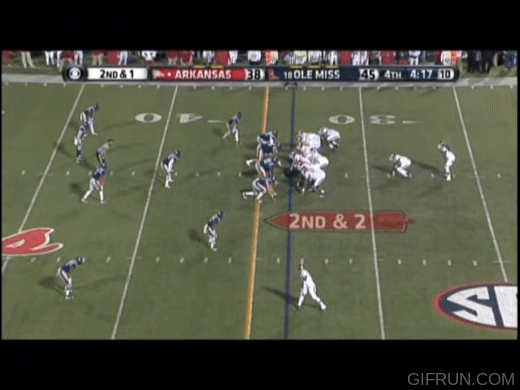
And play-action off those sprint draws was really devastating for the opposing defense, particularly the linebackers:
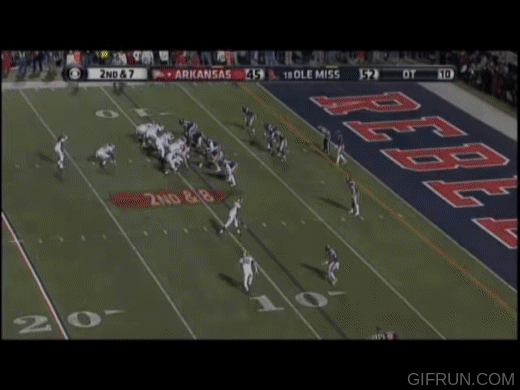
Enos did a nice job of continuing to confuse the defense with sequential playcalls. I don’t think Kendal Briles ever quite mastered this. Most of his most brilliant playcalls were independent of each other.
Here’s an example. In the 2015 Ole Miss game, Arkansas hits this play-action flag route for a nice gain:
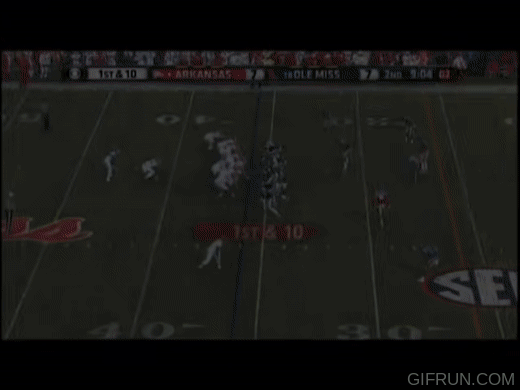
But rather than just be happy with that, the Hogs hit Ole Miss with the same play a few drives later, and except this time, Jared Cornelius is going to break in, converting the route to a post instead of a flag:
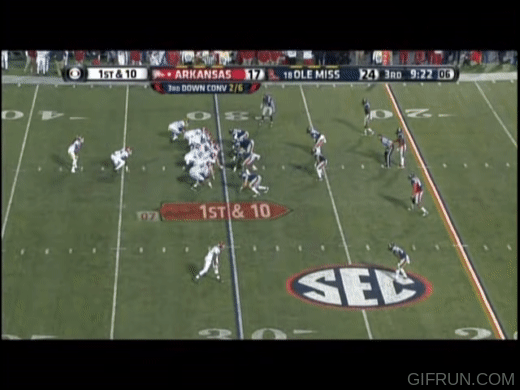
That’s two huge plays for the price of one. That’s what you get with a good play caller.
While KJ Jefferson could certainly benefit from simpler reads and more opportunities to throw deep off play-action, what Arkansas did then isn’t perfect for the current personnel. The under-center stuff, for example, doesn’t suit Jefferson. And the 22 personnel sets are a bit heavy for the modern SEC.
Alabama, 2018
Enos went to Alabama, where he served as QB coach under Saban and OC Mike Locksley. The Tide ran the “spread coast” offense that Lane Kiffin installed for Saban. Enos was now coaching in a scheme that was exclusively shotgun (or pistol) and was heavy in its use of RPOs. His quarterback, Tua Tagovailoa, who had taken over for Jalen Hurts in the previous year’s national title game, set the FBS record for passer efficiency and finished second in Heisman Trophy voting.
Miami, 2019
Enos was considered a hot commodity when Manny Diaz hired him after that season to copy the Spread Coast offense at Miami. Unfortunately, it did not go well. Miami’s offensive line was quite bad, which was the root of the problem. Original starting QB Jarren Williams looked good as a passer but struggled to deal with the constant pressure he was under. An attempt to replace him with N’Kosi Perry backfired, as Perry was quite bad. When the Hurricanes put Williams back in, he too looked bad, and Miami ended the season on a three-game losing streak, including a 14-0 loss to Louisiana Tech in the bowl game. Enos resigned after the season.
Cincinnati, 2020
Enos served on Luke Fickell’s Cincinnati staff as running backs coach in 2020.
Maryland, 2021-2022
Enos and Locksley teamed up for a second time in College Park. Locksley was hired by the Terps after the 2018 Alabama season but had struggled during his first two seasons. Enos quickly brought QB Taulia Tagovailoa along and helped the Maryland offense improve. The younger Tagovailoa threw for 3,008 yards this season as Maryland went 8-5.
Watching Maryland, I see a lot of the same basic ideas that Enos ran in Fayetteville, just out of a more modern look.
Here’s a typical early-down throw to get the quarterback comfortable:
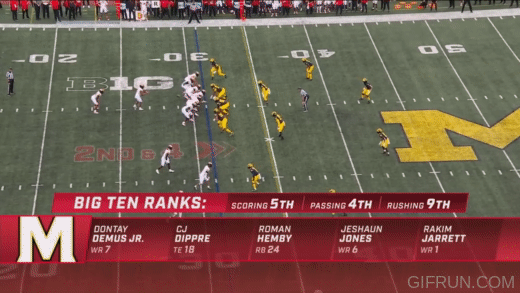
And the tight end will be used. Here, the Terps are in 11 personnel with a wing TE. Maryland uses some motion as window dressing and then sets up a nice shovel RPO:
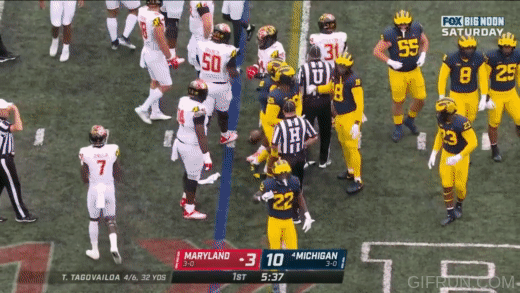
Now they’ll use the wing TE as a fullback for a little insert run:
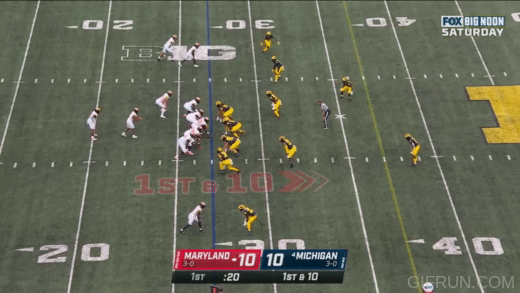
We haven’t seen Arkansas run the ball with a lead blocker like that very much over the last several years.
All of those easy passes and downhill runs are setting up this: play-action. This is a beauty: a deep crossing route off a power run (note the pulling guard):
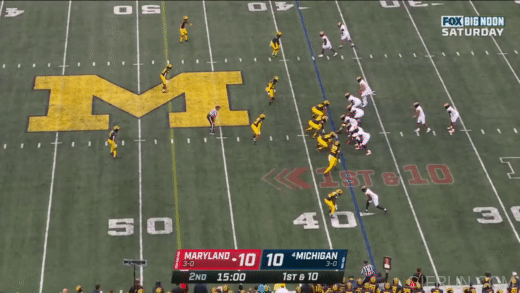
All of this should look pretty familiar to Hog fans, because it is.
What changes has Enos made since leaving Fayetteville?
Since leaving Arkansas, Enos has added some RPOs to his scheme. Not nearly as much as Briles, but you will see some. And his under-center days are over: Maryland was pretty much exclusively shotgun or pistol this year. You’ll see almost exclusively base 11 personnel, compared to his first Arkansas stint, when the Hogs were only 11 personnel in passing situations.
Other than that, it’s the same basic offense.
How could the Enos hire fail?
It’s always important to know what needs to go right and what the pressure points are. For Travis Williams at DC, the key will be recruiting and development, particularly on the defensive line. That’s obviously true to an extent for Enos too.
For Enos, it’s pretty simple: protecting the quarterback. When Enos offenses go sideways, you can always look at the sack numbers. Enos has never used a lot of max protection because he likes to get his tight ends out into passing routes. And while the quick passing game helps get the QB on rhythm, Enos prefers long-developing passing concepts to push the ball down the field.
In 2016, Austin Allen took 34 sacks and was pressured on more than 40% of dropbacks. In 2019 at Miami, Hurricanes quarterbacks somehow took 51 sacks. Even this year, Maryland QBs took a combined 43 sacks and the team finished 115th out of 130 teams in Adjusted Sack Rate.
This helps explain why the 2015 offense was so good: Brandon Allen was sacked just 14 times all year. Allen had some underrated escapability, but that Sam Pittman-coached line was vital to Arkansas’ success. And this is why this hire makes so much sense. Pittman is betting on his offensive line to be elite. He hired the perfect offensive coordinator to take advantage of that.
Thanks for reading! Be sure to follow us on Twitter and on Facebook.
The latest from Fayette Villains, straight to your inbox
Enter your email to subscribe and receive new post alerts and other updates. You can unsubscribe at any time.
